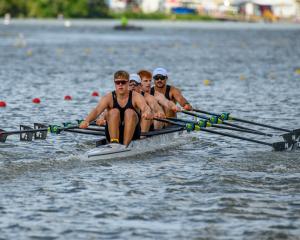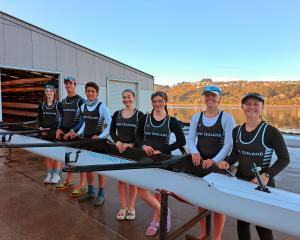
In those early years, steamers carried spectators to Port Chalmers for regattas, but once the railway was opened in 1872, special excursion trains took fans to the port.
The Otago Rowing Club was also formed in 1873, as was another Port Chalmers club, the Union. The latter eventually disbanded and Queen’s Drive Boating Club was created.
The rivalry between Port Chalmers and Queen’s Drive prompted the creation of the most sought-after rowing prize in New Zealand, the “Boss Rooster”. In 1946, the Port crew won the champion fours and, with the title, came not only the Boss Rooster but the honour of holding the New Zealand championships at Port Chalmers in 1948.
Post-war issues and scarce resources eventually led to the amalgamation of the clubs to create Port Chalmers United Rowing Club in 1959. A new clubhouse was built at Careys Bay in 1965 with mostly voluntary labour.
The past 50 years have witnessed a transformation. Old wooden boats and oars have been replaced by fibreglass, kevlar and carbon-fibre models, our 1947 Bedford truck (used in the 1980s) is outshone by a 4WD ute, and our home exercises and medicine balls are redundant in favour of ergs and weights.
The male-dominated sport of the 1970s slowly changed following the introduction of women’s rowing to the 1976 Olympics over the shorter 1000m distance. Now, nearly 50 years later, the club is made up of mainly masters women, many of whom have competed at world masters championships. Those to be crowned world champions are Lesley Bolton, Robyn Cameron, Imogen Coxhead, Michelle Johnston and Karen Thomson.
The sport is not for everyone, but the club has welcomed many aspiring rowers over the years.
The harbour has become busier and we find ourselves rowing alongside huge cruise ships and giving way to more fishing boats and leisure boats, avoiding crayfish buoys, windsurfers, kayakers and watching jet skis zoom along. New dangers are the sea lions which now live on the harbour.
A permanent feature are the beacons, and tales abound of rowers finding themselves wrapped around a beacon — or maybe ejected from the boat completely. The rocks at Rocky Point have also brought at least one double to a halt.
The constant throughout the past 50 years is life member Ray Sinclair. He has transitioned from a talented rower to a knowledgeable coach, who prides himself on his boat maintenance skills and is our jack of all trades with a genuine love of the sport and the club.
While we move backwards on the water, we like to think the club is moving forwards, albeit in a different manner to 50 years ago.












